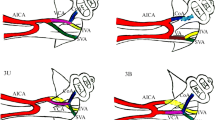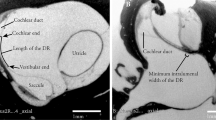Summary
-
1.
The development of Labyrinthula coenocystis is described.
-
2.
The nuclear and cytoplasmic structures of the cells show no essential differences in their various stages of development.
-
3.
Each cell in the aggregate-cyst and in the thread-like pathways is not only surrounded by its own cell membrane but also by an additional unit membrane. This unit membrane is termed inner “Hüllmembran”. In certain “organelles” this passes over into the cell membrane.
-
4.
All the cells of an aggregate-cyst are surrounded by a common unit membrane, the outer “Hüllmembran”.
-
5.
Only in cells of old aggregate-cysts are bodies encountered with concentrically layered membranes. With changes in life conditions these membranes seem to undergo a transformation into vesicles and microtubules and finally into mitochondrial structures.
-
6.
During nuclear division centrioles appear at the outer nuclear membrane which then vanish during the following cell fission. Centrioles could not be demonstrated in interphase nuclei.
-
7.
In the mobile stage individual cells, surrounded by their inner “Hüllmembran” glide within a tube system the walls of which consist of a unit membrane. These tubes contain vesicular or granular material and fibrillar differentiations.
-
8.
The fine structure of an “organelle” which is characteristic of Labyrinthula is described, and the associated membrane relationships in this part of the cell are explained.
Zusammenfassung
-
1.
Die Entwicklung von Labyrinthula coenocystis wird beschrieben.
-
2.
Die Kern- und Plasmastrukturen der Zellen zeigen in den verschiedenen Entwicklungsstadien keine wesentlichen Veränderungen.
-
3.
Jede Zelle ist sowohl innerhalb der Aggregatcyste als auch in der Fadenbahn zusätzlich zu ihrer Zellmembran noch von einer weiteren Elementarmembran umgeben. Diese wird als innere Hüllmembran bezeichnet. Sie geht an bestimmten „Organellen“ in die Zellmembran über.
-
4.
Alle Zellen einer Aggregatcyste werden gemeinsam von einer Elementarmembran, der äußeren Hüllmembran, umgeben.
-
5.
Nur in Zellen alter Aggregatcysten werden Körper mit konzentrisch geschichteten Membranen gefunden. Diese Membranen unterliegen wahrscheinlich bei einer Änderung der Lebensbedingungen der Zellen einer Transformation über Vesikel und Mikrotubuli in Mitochondrienstrukturen.
-
6.
Bei der Kernteilung treten an der Kernhülle Centriole auf, die während der daran anschließenden Zellteilung wieder verschwinden. An Interphasekernen konnten keine Centriole nachgewiesen werden.
-
7.
Im Wanderstadium gleiten die einzelnen Zellen, umgeben von ihrer inneren Hüllmembran, in einem System von Schläuchen, deren Wandung aus einer Elementarmembran besteht. Die Schläuche sind nicht optisch leer, sondern enthalten vesikuläres bzw. granuläres Material und fibrilläre Differenzierungen.
-
8.
Es wird der Feinbau eines für Labyrinthula charakteristischen Organells beschrieben, und die damit zusammenhängenden Membranverhältnisse in diesem Zellbereich werden aufgeklärt.
Similar content being viewed by others
Literatur
Alexopoulos, C. J.: Einführung in die Mykologie. Stuttgart: Gustav Fischer 1966.
Amon, J. P., Perkins, F. O.: Structure of Labyrinthula sp. Zoospores. J. Protozool. 15, 543–546 (1968).
Aschner, M.: Isolation of Labyrinthula macrocystis from soil. Bull. Res. Coun. Israel D6, 174–179 (1958).
—, Kogan, S.: Observations on the growth of Labyrinthula macrocystis. Bull. Res. Coun. Israel D8, 15–24 (1959).
Bonner, J. T.: The cellular slime molds. Princeton, New Jersey: Princeton Univ. Press 1967.
Bygrave, F. L., Kaiser, W.: The magnesium-dependent incorporation of serine in the phospholipids of mitochondria isolated from the developing flight muscle of the African locust Locusta migratoria. Europ. J. Biochem. 8, 16–22 (1969).
Chadefaud, M.: Sur un Labyrinthula de Roscoff. C. R. Acad. Sci. (Paris) 243, 1794–1797 (1956).
Cienkowski, L.: Über den Bau und die Entwicklung der Labyrinthulen. Arch. mikr. Anat. 3, 274–320 (1867).
—: Über einige Rhizopoden und verwandte Organismen. Arch. mikr. Anat. 12, 15–50 (1876).
Dangeard, P. A.: Observation sur la famille des Labyrinthuleés et sur quelques autres parasites des Cladophora. Botaniste 24, 217–258 (1932).
David, H.: Untergang der Mitochondrien. In: Bielka, H., Molekulare Biologie der Zelle. Jena: Gustav Fischer 1969.
Djaczenko, W., Grabska, J., Urbanowicz, M., Pezzi, R.: Peculiar mitochondrial forms in the liver parenchymal cells of rats kept on vitamine E deficient diet. J. Microscopie 8, 139–144 (1969).
Doflein, F., Reichenow, E.: Lehrbuch der Protozoenkunde. Jena: Gustav Fischer 1952.
Grell, K. G.: Protozoologie, 2. Aufl. Berlin-Heidelberg-New York: Springer 1968.
Hall, R. P.: Protozoology. New York: Prentice-Hall 1959.
Hedley, R. H., Parry, D. M., Wakefield, J. St. W.: Fine structure of Shepheardella taeniformis (Foraminifera: Protozoa). J. roy. micr. Soc. 87, 445–456 (1967).
Hohl, H. R.: The fine structure of the slimeways in Labyrinthula. J. Protozool. 13, 41–43 (1966).
Hollande, A., Enjumet, M.: Sur l'évolution et la systématique des Labyrinthulidae. Ann. Sci. nat., Zool. 17, 357–368 (1955).
Honigberg, B. M., Balamuth, W., Bovee, E. C., Corliss, J. Ob., Gojdics, M., Hall, R. P., Kudo, R. R., Levine, N. D., Loeblich, A. R., Weiser, J., Wenrich, D. H.: A revised classification of the phylum protozoa. J. Protozool. 11, 7–20 (1964).
Jepps, M. W.: Note on a marine Labyrinthula. J. mar. biol. Ass. U. K. 17, 833–838 (1931).
Klie, H., Schwartz, W.: Untersuchungen über Lebensweise und Kultur von Labyrinthula. Z. allg. Mikrobiol. 3, 15–24 (1963).
Kudo, R. R.: Protozoology, Springfield, Ill.: Thomas 1966.
Levine, N. D., Corliss, J. O.: Two new subclasses of sarcodines, Labyrinthulia subcl. nov. and Proteomyxidia subcl. nov. (Abstr.) J. Protozool. 10, (Suppl.) 27, 1963.
Pokorny, K. S.: Labyrinthula, J. Protozool. 14, 697–708 (1967).
Porter, D.: Motility in Labyrinthula. Amer. J. Bot. (Abstr.) 54, 648 (1967).
Renn, C. E.: Demonstration of Labyrinthula parasite in eel-grass from the coast of California. Science 95, 122 (1942).
Roodyn, D. B., Wilkie, D.: The biogenesis of mitochondria. London: Methuen 1968.
Schmidt, E. W.: Myxophyta. Schleimpilze. In: Englers Syllabus der Pflanzenfamilien, 12. Aufl. Bd. 1. Berlin: Gebr. Borntraeger 1954.
Schmoller, H.: Kultur und Entwicklung von Labyrinthula coenocystis n. sp. Arch. Mikrobiol. 36, 365–372 (1960).
—: Zur Entwicklung der Labyrinthulen. Arch. Mikrobiol. 40, 224–230 (1961).
Schmoller, H.: Die Natur der Labyrinthulen. Naturwissenschaften 53, 711–712 (1966).
—: Beitrag zur Kenntnis der Labyrinthulen-Enwicklung. Arch. Protistenk. 109, 226–244 (1966).
—: Die Bewegung der Labyrinthulen. Naturwissenschaften 54, 345 (1967).
Schwab, D.: Nachweis von Centriolen bei Myxotheca. Naturwissenschaften 55, 88 (1968).
Stey, H.: Nachweis eines bisher unbekannten Organells bei Labyrinthula. Z. Naturforsch. 23 b, 567 (1968).
Valkanov, A.: Die Natur und die systematische Stellung der Labyrinthuleen. Arch. Protistenk. 67, 110–121 (1929).
Vishniac, H. S.: The nutritional requirements of Labyrinthula spp. J. gen. Microbiol. 12, 455–463 (1955).
Watson, S. W., Raper, K. B.: Labyrinthula minuta sp. nov. J. gen. Microbiol. 17, 368–377 (1957).
Wohlfarth-Bottermann, K. E.: Cytologische Studien VIII. Zum Mechanismus der Cytoplasmaströmung in dünnen Fäden. Protoplasma 54, 1–26 (1962).
Young, E. L.: Studies on Labyrinthula. The etiologic agent of the wasting disease of eelgrass. Amer. J. Bot. 30, 589–593 (1943).
Zopf, W.: Zur Kenntnis der Labyrinthuleen, einer Familie der Mycetozoen. Beitr. Physiol. Morph. nied. Organ. 2, 36–48 (1892).
Author information
Authors and Affiliations
Additional information
Herrn Prof. Dr. K. G. Grell danke ich für die Anregung zu dieser Arbeit und sein Interesse am Fortgang der Untersuchung.
Rights and permissions
About this article
Cite this article
Stey, H. Elektronenmikroskopische Untersuchung an Labyrinthula coenocystis Schmoller. Z. Zellforsch. 102, 387–418 (1969). https://doi.org/10.1007/BF00335447
Received:
Issue Date:
DOI: https://doi.org/10.1007/BF00335447




